Related Research Articles
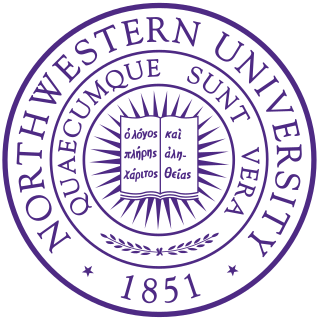
Northwestern University Feinberg School of Medicine is the medical school of Northwestern University and is located in the Streeterville neighborhood of Chicago, Illinois. Founded in 1859, Feinberg offers a full-time Doctor of Medicine degree program, multiple joint degree programs, graduate medical education, and continuing medical education.

Desmoglein-1 is a protein that in humans is encoded by the DSG1 gene. Desmoglein-1 is expressed everywhere in the skin epidermis, but mainly it is expressed in the superficial upper layers of the skin epidermis.

Desmoglein-2 is a protein that in humans is encoded by the DSG2 gene. Desmoglein-2 is highly expressed in epithelial cells and cardiomyocytes. Desmoglein-2 is localized to desmosome structures at regions of cell-cell contact and functions to structurally adhere adjacent cells together. In cardiac muscle, these regions are specialized regions known as intercalated discs. Mutations in desmoglein-2 have been associated with arrhythmogenic right ventricular cardiomyopathy and familial dilated cardiomyopathy.

Northwestern Memorial Hospital (NMH) is a nationally ranked academic medical center located on Northwestern University’s Chicago campus in Streeterville, Chicago, Illinois. It is the flagship campus for Northwestern Medicine and the primary teaching hospital for the Feinberg School of Medicine at Northwestern University. Affiliated institutions also located on campus include the Ann & Robert H. Lurie Children's Hospital with Level I pediatric trauma care and the Shirley Ryan AbilityLab, a leader in physical medicine and rehabilitation.

Desmoplakin is a protein in humans that is encoded by the DSP gene. Desmoplakin is a critical component of desmosome structures in cardiac muscle and epidermal cells, which function to maintain the structural integrity at adjacent cell contacts. In cardiac muscle, desmoplakin is localized to intercalated discs which mechanically couple cardiac cells to function in a coordinated syncytial structure. Mutations in desmoplakin have been shown to play a role in dilated cardiomyopathy, arrhythmogenic right ventricular cardiomyopathy, striate palmoplantar keratoderma, Carvajal syndrome and paraneoplastic pemphigus.

Plakoglobin, also known as junction plakoglobin or gamma-catenin, is a protein that in humans is encoded by the JUP gene. Plakoglobin is a member of the catenin protein family and homologous to β-catenin. Plakoglobin is a cytoplasmic component of desmosomes and adherens junctions structures located within intercalated discs of cardiac muscle that function to anchor sarcomeres and join adjacent cells in cardiac muscle. Mutations in plakoglobin are associated with arrhythmogenic right ventricular dysplasia.
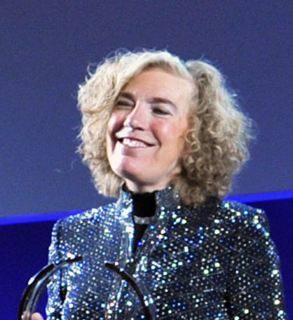
Elaine V. Fuchs is an American cell biologist, famous for her work on the biology and molecular mechanisms of mammalian skin and skin diseases, who helped lead the modernization of dermatology. Fuchs pioneered reverse genetics approaches, which assess protein function first and then assess its role in development and disease. In particular, Fuchs researches skin stem cells, and their production of hair and skin. She is an investigator at the Howard Hughes Medical Institute and the Rebecca C. Lancefield Professor of Mammalian Cell Biology and Development at The Rockefeller University.

Keratin 5, also known as KRT5, K5, or CK5, is a protein that is encoded in humans by the KRT5 gene. It dimerizes with keratin 14 and forms the intermediate filaments (IF) that make up the cytoskeleton of basal epithelial cells. This protein is involved in several diseases including epidermolysis bullosa simplex and breast and lung cancers.

Dystonin(DST), also known as bullous pemphigoid antigen 1 (BPAG1), isoforms 1/2/3/4/5/8, is a protein that in humans is encoded by the DST gene.

Plakophilin-2 is a protein that in humans is encoded by the PKP2 gene. Plakophilin 2 is expressed in skin and cardiac muscle, where it functions to link cadherins to intermediate filaments in the cytoskeleton. In cardiac muscle, plakophilin-2 is found in desmosome structures located within intercalated discs. Mutations in PKP2 have been shown to be causal in arrhythmogenic right ventricular cardiomyopathy.
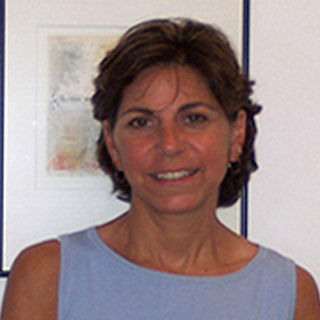
Diane L. Barber, from Marin County, California, is an American cell physiologist and cell biologist. She is professor and chair of the Department of Cell and Tissue Biology at University of California, San Francisco School of Dentistry. In 2012 she became elected Fellow of the American Association for the Advancement of Science as recognition for her "distinguished contributions on cell signaling by plasma membrane ion transport proteins and on the design and function of proteins regulated by intracellular pH dynamics."
Valerie Horsley is an American cell and developmental biologist. She currently works as an associate professor at Yale University, where she has extensively researched the growth, restoration, and maintenance of skin cells. She is a currently a member of the Yale Cancer Center and Yale Stem Cell Center. She received a Presidential Early Career Award for Scientists and Engineers in 2012 and in 2013 she was the recipient of the Rosalind Franklin Young Investigator Award.

Gary G. Borisy is a retired president and director of the Marine Biological Laboratory in Woods Hole, Massachusetts. In 2013, Borisy joined the Department of Microbiology at the Forsyth Institute.
Robert D. Goldman is an American cell and molecular biologist. He was the Chair of the Department of Cell and Molecular Biology at Northwestern University Feinberg School of Medicine and held the Stephen Walter Ranson Professor of Cell Biology at the institution. He is currently a Professor of Cell and Developmental Biology at Feinberg.
Irene May Leigh OBE CBE FRSE FMedSci is a British dermatologist. A former professor of Barts and The London School of Medicine and Dentistry, she is now a professor emeritus at the University of Dundee School of Medicine. Her research has focused on keratinocytes, non-melanoma skin cancers and genetic skin diseases. She was elected to the Academy of Medical Sciences in 1999 and appointed CBE in 2012.
Karla Satchell, born Karla Fullner, is an American microbiologist who is currently a professor at Northwestern University Feinberg School of Medicine and an elected fellow of the American Association for the Advancement of Science.
Valentina Greco is an Italian-born biologist who teaches at the Yale School of Medicine as the Carolyn Walch Slayman Professor of Genetics and is an Associate Professor in the Cell Biology and Dermatology departments. Her research focuses on the role of skin stem cells in tissue regeneration.
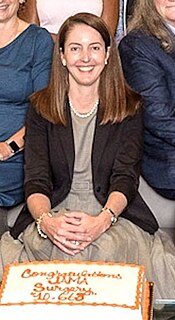
Melina R. Kibbe is an American clinician and researcher in the field of vascular surgery. She currently serves as Dean of the University of Virginia School of Medicine. She previously held the Colin G. Thomas Jr. Distinguished Professorship and Chair of the Department of Surgery at UNC School of Medicine.

Erika L F. Holzbaur is an American biologist who is the William Maul Measey Professor of Physiology at University of Pennsylvania Perelman School of Medicine. Her research considers the dynamics of organelle motility along cytoskeleton of cells. She is particularly interested in the molecular mechanisms that underpin neurodegenerative diseases.
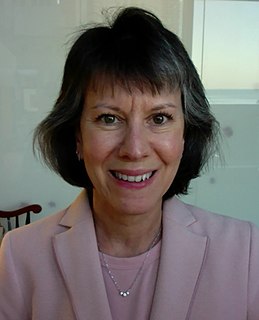
Elizabeth M. McNally is an American human geneticist and cardiologist. She is the Elizabeth J. Ward Chair and director of the Center for Genetic Medicine at Northwestern University's Feinberg School of Medicine.
References
- 1 2 "Kathleen Green Lab". Feinberg School of Medicine . Northwestern University . Retrieved 23 April 2021.
- ↑ "Green Appointed Associate Director for Basic Sciences Research". Robert H. Lurie Comprehensive Cancer Center of Northwestern University. Retrieved 23 April 2021.
- ↑ Fleischman, John. "ASCB Profile: Kathy Green" (PDF). www.ascb.org. American Society for Cell Biology. Retrieved 27 April 2021.
- ↑ "Editor biographies". Journal of Cell Science. Journal of Cell Science. Retrieved 23 April 2021.
- ↑ "Honorary Members". Society of Investigative Dermatology. Society for Investigative Dermatology. Retrieved 23 April 2021.
- ↑ Bemis, Amber (March 29, 2019). "Green Wins 2019 Tripartite Prize". Feinberg News Center. Northwestern University Feinberg School of Medicine. Retrieved 23 April 2021.
- ↑ "American Skin Association Honors Outstanding Researchers during Annual Meeting of the Society for Investigative Dermatology: Dr. Kathleen Green 26th Recipient of David Martin Carter Mentor Award". American Skin Association. American Skin Association. Retrieved 23 April 2021.
- ↑ "Green Honored for Research Accomplishments". Feinberg News Center. Northwestern University Feinberg School of Medicine. July 29, 2015. Retrieved 23 April 2021.
- ↑ Plumridge, Sarah (August 25, 2016). "Green Elected to German National Academy of Sciences". Feinberg News Center. Northwestern University Feinberg School of Medicine. Retrieved 23 April 2021.
- ↑ Dusek, Rachel L; Godsel, Lisa M.; l, Kathleen J. (January 2007). "Discriminating roles of desmosomal cadherins:Beyond desmosomal adhesion". Journal of Dermatological Science. 45 (1): 7–21. doi:10.1016/j.jdermsci.2006.10.006. PMID 17141479 . Retrieved 23 April 2021.